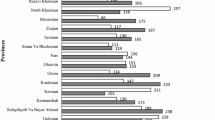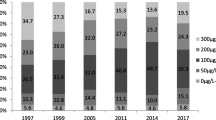Abstract
Iodine deficiency disorders (IDD) were prevalent in the Islamic Republic (IR) of IRAN before 1989, when the national salt iodization program with 40 mg I/k of salt was initiated. Despite a comprehensive IDD control program, less than 50% of the households in rural areas consumed iodized salt by 1994. A law for the mandatory production of iodized salt for households was passed in 1994. The purpose of this study was to evaluate goiter status and urinary iodine excretion 2 yr after this law was implemented. In each of 26 provinces, 30 groups of 40 schoolchildren, total 36,178, were examined for goiter and classified according to World Health Organization (WHO) classification. Urinary iodine excretion was measured in 2,917 children by digestion method. Goiter was endemic in all provinces, but the majority were small (grade 1) goiter. Median urinary iodine was 20.5 μg/dl 85.1% had urinary iodine ≥10 μg/dl. Median urinary iodine was above 13 μg/dl in all 26 provinces. In all provinces the percentage of schoolchildren with urinary iodine <5 μg/dl was less than 16%. In nine provinces the median urinary iodine was between 13 to 20 μg/dl; urinary iodine of their schoolchildren was <5 μg/dl in 10.8% and <2 μg/dl in 6–9%. No significant difference was observed between boys and girls or children of rural and urban regions in urinary iodine excretion. We conclude that 7 yr after the beginning of salt iodization and 2 yr following mandatory iodized salt consumption, urinary iodine excretion is adequate in schoolchildren; considering the data of the percent of households consuming iodized salt and programmatic setting of the IDD program, The IR of Iran has reached a sustainable control program for iodine deficiency.
Similar content being viewed by others
References
Hetzel B.S. Iodine deficiency disorders and their eradication. Lancet 1983, 2: 1126–1129.
WHO/UNICEF/ICCIDD. Global prevalence of iodine deficiency disorders. MDIS Working Paper No. I. Micronutrient Deficiency Information System. Geneva, World Health Organization, 1993.
Emami A., Shahbazi H., Sabzevari M., et al. Goiter in Iran. Amer. J. Clin Nutr. 1969, 22: 1584–1588.
Azizi F., Kimiagar M., Bastani J., Navai L., Ghazanfari F. Evaluation of goiter in Shariar. J. Beheshti Med. Sch. 1985, 9: 75–80, (Farsi).
Azizi F., Kimiagar M., Navai L., Nafarabadi M. Goiter in Tehran and suburbs In: Vjichayanart A., et al. (Eds.), Recent progress in thyroidology. Proceedings of the third Asia and Oceania Thyroid Association meeting. Dec. 4-6 1986, p. 388–391.
Kimiagar M., Azizi F., Navai L., Yassai M., Nafarabadi M. Survey of iodine deficiency in a rural area near Tehran: association of food intake and endemic goiter. Eur. J. Clin. Nutr. 1990, 44: 17–22.
Kimiagar M., Yassai M., Nafarabadi M., Sammimi B., Azizi F. Endemic goiter in Boyer Ahmad. Med. J. IRI. 1989, 3: 27–29.
Azizi F., Kimiagar M., Nafarabadi M., Yasai M. Current status of iodine deficiency disorders in the Islamic Republic of Iran. EMR. Health Serv. J. 1990, 8: 23–27.
Azizi F. Monitoring of IDD prevention. Proceedings of the Fifth International Congress of Endocrine Disorders. 6-9 Sept. 1999, Tehran, I.R. Iran, p. 9.
WHO/UNICEF/ICCIDD. Indicators for assessing iodine deficiency disorders and their control through salt iodization. Geneva, WHO/NUT/94.6, 1994
Dunn J.T., Crutchfield M.E., Gutekunst R., Dunn A.N. Methods for measuring iodine in urine. Geneva, ICCIDD/ UNICEF/WHO publication, 1993.
Azizi F. Iodine Deficiency Disorders in the Republic of Yemen. Assignment Report No. WHO/EMORO/EM/NUT/ 106/E/R/12.91/30. Alexandria, World Health Organization, EMRO.
WHO/UNICEF/ICCIDD. IDD in the Middle East. IDD Newsletter. 1993, 9: 13–17.
WHO/EMRO. Assessment of monitoring of iodine deficiency disorders in countries of the eastem Mediterranean region. Report of a symposium-workshop, 9-11 Sept. 1999, Tehran, I.R. Iran, 2000.
Azizi F., Sarshar A., Nafarabadi M., et al. Impairment of neuromotor and cognitive development in iodine deficient schoolchildren with normal physical growth. Acta End-ocrinol. 1993, 129: 501–504.
Azizi F., Kalani H., Kimiagar M., et al. Physical, neuromotor and intellectual impairment in non-cretinous schoolchildren with iodine deficiency. Int. J. Vitam. Nutr. Res. 1995, 65: 199–205.
Aghini-Lombardi F., Antonangeli L., Pinchera A., et al. Effect of iodized salt on thyroid volume of children living in an area previously characterized by moderate iodine deficiency. J. Clin. Endocrinol. Metab. 1997, 82: 1136–1139.
Azizi F., Delshad H., Mehrabi Y. Thyroid volumes in schoolchildren of Tehran: Comparison with European schoolchildren. J. Endocrinol. Invest. 2001, 24: 756–762.
Dunn J.T., Van Der Haar F. A practical guide to the correction of iodine deficiency. WHO/IDDIDD/UNICEF, Wageningen, 1990, p 14.
WHO/UNICEF/ICCIDD. Assessment of the Iodine Deficiency Disorders and Monitoring Their Elimination. Report of Consultation, May 4-6, A guide for programme managers 2000, 2nd ed., WHO/NHD/01.1, Geneva, 2001.
Stanbury J.B., Ermans A.E., Boudroux P., et al. Iodine-induced hyperthyroidism: Occurrence and epidemiology. Thyroid 1998, 8: 83–100.
Azizi F., Daftarian N. Side-effects of iodized oil administration in patients wìth simple goiter. J. Endocrinol. Invest. 2001, 24: 72–77.
Rahmani M., Allahverdian S., Hedayati M., Azizi F. Evaluation of urinary iodine and thyroid function tests in Rasht and Sari. East. Mediterr. Health J. In press.
Rahmani M., Kouhkan A., Allahverdian S., Hedayati M., Azizi F. Comparison of dietary iodine intake and urinary excretion in urban and rural households of Ilam. Iranian J. Endocrinol. Metab. 2000, 2: 31–38, (Farsi).
Author information
Authors and Affiliations
Corresponding author
Rights and permissions
About this article
Cite this article
Azizi, F., Sheikholeslam, R., Hedayati, M. et al. Sustainable control of iodine deficiency in Iran: Beneficial results of the implementation of the mandatory law on salt iodization. J Endocrinol Invest 25, 409–413 (2002). https://doi.org/10.1007/BF03344029
Accepted:
Published:
Issue Date:
DOI: https://doi.org/10.1007/BF03344029




